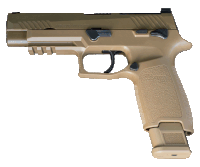Douanes Limitanei: Difference between revisions
Tag: 2017 source edit |
Tag: 2017 source edit |
||
| Line 107: | Line 107: | ||
==Equipment== | ==Equipment== | ||
===Service weapons=== | |||
{| class="wikitable" | |||
!Name | |||
!Origin | |||
!Type | |||
!Calibre | |||
!Photo | |||
!Notes | |||
|- | |||
|[[MAG-17]]CY | |||
| {{flag|Yonderre}} | |||
|Pistol | |||
|9mm parabellum | |||
|[[File:Sig_Sauer_M17_transparent.gif|200px]] | |||
| | |||
|- | |||
|{{wp|IMBEL MD97}} | |||
| {{flag|Burgundie}} | |||
|Battle rifle | |||
|7.62mm | |||
|[[File:Ia2_ctt.jpg|200px]] | |||
|Standard issue rifle for the [[Army_of_Burgundie#Metropole_Forces|Metropole Forces]]. Will phase out in favor of the {{wpl|FN_SCAR#HAMR_IAR|HAMR}}/[[SAR-99#SAR-99L|SAR-99L]] over the next 5-10 yrs. | |||
|- | |||
|} | |||
==See also== | ==See also== | ||
Revision as of 23:11, 2 March 2025
| Douanes Limitanei | |
|---|---|
 | |
| Agency overview | |
| Formed | 1647 |
| Preceding agencies |
|
| Employees | 36,584 |
| Jurisdictional structure | |
| Operations jurisdiction | Burgundie |
| Legal jurisdiction | Burgoignesc Metropole borders |
| Primary governing body | Ministry of the Interior |
| Secondary governing body | Security Services Bureau |
| General nature | |
| Operational structure | |
| Headquarters | Vilauristre |
| Parent agency | Ministry of the Interior |
The Douanes Limitanei (Ænglish: Border Customs) is the agency responsible for land-based border control and customs enforcement along the borders of the Burgoignesc Metropole. It works in close cooperation with the maritime gendarmerie and maritime customs agency of Burgundie, the Revenue Guard. It is a civilian law enforcement agency, with 36,584 employees, operating under the authority of the Ministry of the Interior's Security Services Bureau. The agency is responsible for protecting Burgundie's land borders from the illegal entry of people and goods, collecting customs duties and tariffs, and enforcing customs and immigration laws. Since the Burgoignesc Metropole is within the Levantine Union, which has the free movement of people and goods, most of the functions of the Douanes Limitanei are conducted via highway patrol, intelligence and investigation work, and weigh station monitoring.
History
21st century
20th century
First Fratricide and the early republic
In 1849, with the start of the First Fratricide, Dantoine Marius, Duke of Bourgondi established the Capitaines della Guardacostes, simply calling them the Revenue Guard. In 1851, Dantoine used the Sergents della Marechaussee concept to make the Gendarmes d'elite della Gaurdie Real (Elite Gendarmes of the Royal Guard), removing the land-based responsibilities of the Revenue Guard and forming a gendarmerie based on the Custodes Yonderre after the reformation in 1833. At the end of the war, the newly acquired territories still maintained their individual forms of policing. In the 1921 Policing Reform Act policing was centralized and the various forms of gendarmeries, noble/royal guard units with law-enforcement responsibilities and regimental military policing units were consolidated into the Gendarmerie nacional.
Marechaussee and colonial policing
The establishment of the National Constabulary of Burgundie in 1641 led to a reorganization of the Revenue Guard. The Sergents della Marechaussee were separated from the Revenue Guard and became a separate organization, the Marechaussee. The Marechaussee was responsible for policing rural areas and maintaining order outside the cities, particularly on carriage ways and imperial roads.
Founding and Early History
Formed in 1148 by the Triumverate Council the Revenue Guard was a royal institution commanded by a Lord Commandant who oversaw three Sergeants known as the Sergents della Maréchaussée (Sergeants of the Marshalcy), responsible for collecting taxes and arresting highwaymen, and three Captains known as the Capitaines della Guardacostes (Captains of the Coast Guard), responsible for collecting tariffs and suppressing smuggling and piracy. The revenue guard grew in size from its original 7 men to 156.
Organization and structure
The Douanes Limitanei is overseen by an Inspector-General (Burg: Inspector General) (OF-8) and seven Lieutenant Inspectors General (Burg: Teniente Inspectores Generales) one each for the seven units of the Douanes Limitanei:
- Border Patrol: A brigade strength unit responsible for patrolling and maintaining the sovereignty of the borders of Burgoignesc Metropole.
- Customs Enforcement Brigade: Responsible for the inspection of people and goods entering and leaving Burgundie.
- Investigations Directorate: Responsible for investigating customs fraud, smuggling, and trafficking.
- Intelligence and Risk Management Directorate: Responsible for collection and analysis of intelligence related to customs and border security.
- Interagency Coordination Directorate: Responsible for coordinating with other agencies and countries on customs and border security matters.
- Field Support Directorate: Responsible for the support, training, maintenance, and logistics of the Douanes Limitanei.
- Headquarters and Administration Directorate
Interagency Coordination Directorate
The Interagency Coordination Directorate works closely with the Revenue Guard, as the two customs and border patrol agencies of Burgundie. The agency also works with international organizations, such as the Levantine Union (particularly their counterparts in Lapody and Urcea) and the League of Nations on information sharing, training, and investigations.
Equipment
Service weapons
| Name | Origin | Type | Calibre | Photo | Notes |
|---|---|---|---|---|---|
| MAG-17CY | Pistol | 9mm parabellum | 
|
||
| IMBEL MD97 | Battle rifle | 7.62mm | 
|
Standard issue rifle for the Metropole Forces. Will phase out in favor of the HAMR/SAR-99L over the next 5-10 yrs. |
See also
- National Constabulary of Burgundie, civilian police of Burgundie
- National Gendarmerie of Burgundie, military/rural police of Burgundie
- Revenue Guard, maritime gendarmerie and customs agents of Burgundie
- Pages using duplicate arguments in template calls
- Pages using law enforcement agency with civilian police general nature
- Pages using infobox law enforcement agency with unknown parameters
- Pages using country topics with unknown parameters
- Burgoignesc Security Forces
- Law Enforcement Agencies
- Law Enforcement Agencies in Burgundie